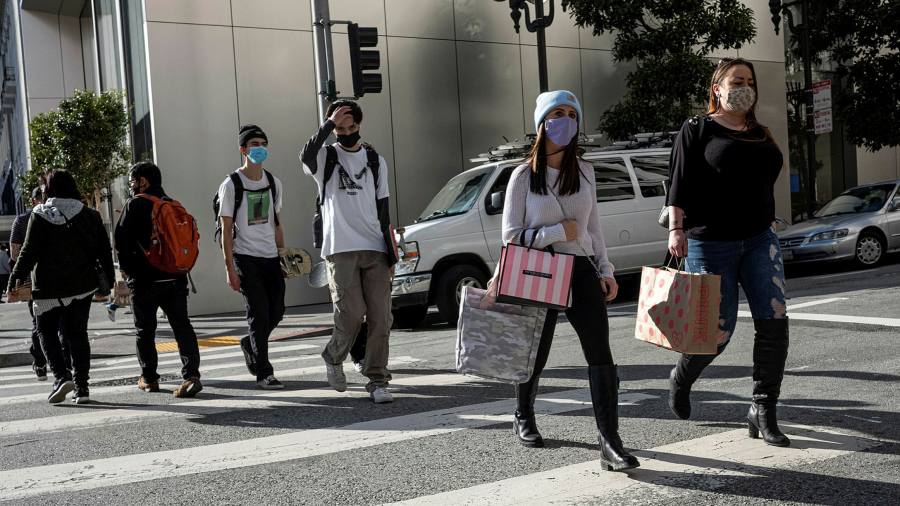[ad_1]
The writer, Morgan Stanley Investment Management’s chief global strategist, is author of ‘Ten Rules of Successful Nations’
It was a jarring image. As deaths from the pandemic rose in 2020, financial markets high on government stimulus partied through a devastating global downturn. Most people expect the revelry to continue as economies recover. But now there are signs the recovery could turn into a boom — and an overheating economy could end the market party. This year could unfold as a mirror image of 2020, with markets going flat amid soaring economic growth.
To understand why, follow the money. After a brief crash last March, markets started rallying the day after the US Federal Reserve announced its first pandemic relief measures — and kept on rallying. Nearly 20 per cent of all dollars in circulation were printed in 2020 alone. Major central banks followed the Fed, and governments topped that up with stimulus spending. US disposable incomes rose at the fastest rate in decades, but much of that went unspent. Americans saved at the highest rate since the second world war, putting away an additional $1.7tn, or more than 16 per cent of their 2020 income.
With more money in the bank, and more time on their hands because of lockdowns, many workers turned to punting in the markets. Of 49m online brokerage accounts in the US, 13m opened in 2020, according to calculations by Scott Rubner of Goldman Sachs. The week after stimulus checks went out in April, trading by middle-class Americans soared.
US retail investors helped fuel flash manias for bankrupt companies like JC Penney, and more recently for another faltering retailer, GameStop. From South Korea to India, individuals bought stocks at a furious pace. The huge winners were large growth stocks, particularly in the US and China. Together they accounted for most of the 2020 market gains worldwide.
Where will all the money go when the virus fades? Epidemiologists say the pandemic could be contained by summer, perhaps even by spring in the US and UK, where vaccines are rapidly rolling out. As consumers emerge from lockdown, excess savings are likely to drop sharply. Even by conservative estimates, the release of pent-up demand could add two to three percentage points to gross domestic product growth in the US alone.
The consensus prediction for global GDP growth in 2021 is just over 5 per cent. But my team thinks growth could top 6 per cent worldwide, and reach 8 per cent in the US. I think other forecasters are underestimating the recovery, given the savings glut and the apparent eagerness of policymakers to err on the side of overstimulating. Ironically, a booming economy may not be good for markets. Savers will become shoppers again. Resurgent demand for leisure travel, fine dining and other services will strain the capacity of industries gutted by the pandemic.
The deflationary impact of business closures could give way to the potentially inflationary impact of supply shortages, which are already visible in sectors such as shipping, airlines and semiconductors. The prices of commodities from oil to soyabeans have also been surging of late.
The bond market is beginning to price in higher inflation, and the prospect of higher yields could suck money out of stocks, which are now much more vulnerable to interest rate swings. Last year stock valuations received an unusually large boost as rates plunged. A sharp rise would deliver a proportionately large shock. Further, the rally was driven mainly by growth stocks — the kind most sensitive to interest rate shifts — and they now dominate many stock market indices.
Higher long-term interest rates could end the extraordinary bull run for giant tech stocks in the US and China and move flows towards a new set of countries and industries. The buzzwords of last year — the virus, virtual, work from home, recession — are likely to make way for vaccines, the real world, back to the office and reflation. This transition may be more disruptive than imagined for financial markets, which have become hooked on last year’s themes and low long-term interest rates.
Markets often underestimate the impact of big shifts in the global economy. In the early 1980s, disinflation led to a sharp fall in interest rates, with much greater fallout for the markets than most investors had foreseen. Now the risk is that inflation resurfaces, and bond yields rise more sharply than anticipated, overwhelming the rise in earnings during a recovery. The impact could easily end the rally of 2020, leaving markets suffering withdrawal symptoms despite a global economic boom.
[ad_2]
Source link






